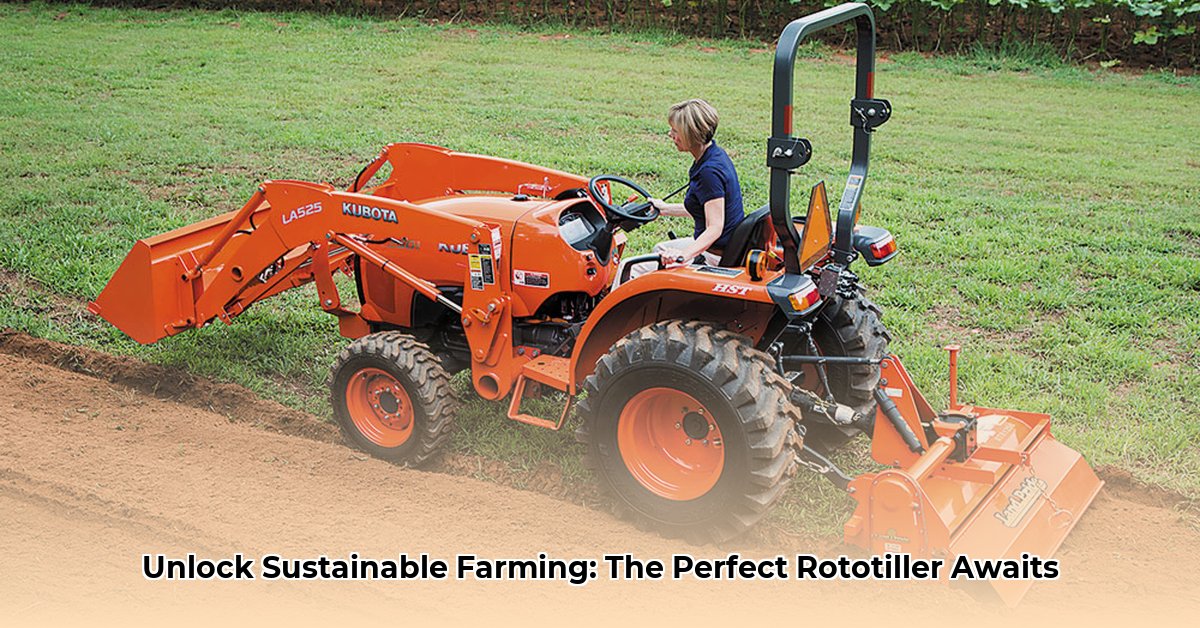
Finding the right rototiller for your sustainable farming operation can seem daunting. This guide helps you navigate the options at Tractor Supply, focusing on brands like CountyLine and King Kutter, to find the perfect tool for your needs. We'll explore factors like size, type, and maintenance, while also considering the broader implications for sustainable agriculture. For more information on Tractor Supply tillers, check out this helpful resource: Tractor Supply Tillers.
Sizing Up Your Needs: Selecting the Right Tiller for Your Land
The first step is assessing your land's size and soil type. A small backyard garden requires a compact, perhaps 3-foot-wide rototiller. Larger plots necessitate a more powerful, wider model. Tractor Supply offers various CountyLine and King Kutter tillers to suit different acreage sizes. Consider the trade-off between speed (wider tillers cover more ground quickly) and maneuverability (narrower tillers are easier to handle in confined spaces). Do you need the speed of a wider tiller, or is maneuverability in tight spaces more important for your farm?
Gear-Driven vs. Other Tillers: A Comparison
Tractor Supply stocks various tiller types, including gear-driven and belt-driven models. Gear-driven tillers are typically more robust and reliable, particularly for heavy clay soils. However, they are usually heavier, more expensive, and less maneuverable. Belt-driven models offer a lighter, more affordable, and more maneuverable alternative, but may struggle with challenging soil conditions or extensive use. Electric tillers offer a quieter and potentially more environmentally friendly option, but may have limitations in power or availability. Choosing the right type depends heavily on your specific needs and budget. What soil type will you primarily be tilling?
Key Features to Consider When Shopping
Before visiting Tractor Supply, consider these vital features:
Horsepower: Higher horsepower translates to more tilling power. Larger properties or challenging soils will need more horsepower.
Tiller Width: This determines the ground covered per pass. Wider tillers are faster but sometimes harder to manage in tight spaces.
Depth Control: Adjustable depth settings allow customization based on soil type and tilling depth requirements.
Price: Establish a clear budget beforehand. While initial cost matters, a higher-quality tiller may reduce long-term repair costs, making it a more cost-effective option in the long run.
Maintaining Your Tiller: Essential Practices
Regular maintenance maximizes your tiller's lifespan and performance. This includes:
Cleaning: Remove soil and debris after each use to prevent corrosion and buildup.
Belt Inspection: Regularly check the belts for wear and tear; timely replacement is crucial.
Tine Sharpening: Dull tines decrease efficiency and damage the tiller. Sharpen them for optimal performance.
Oil Changes: Follow the manufacturer's recommendations for consistent oil changes to ensure engine longevity.
Rototillers, Sustainability, and Future Trends
While detailed data on the environmental impact of specific Tractor Supply tiller models is limited, the future of sustainable agriculture demands eco-friendly choices. We need greater transparency from manufacturers regarding fuel efficiency and emissions. The rise of electric tillers promises to reduce environmental impact, but they might not yet fit all needs. The future might also include refined tilling techniques that minimize soil disturbance. How can transparency regarding fuel efficiency be improved for consumers?
Conclusion: Your Path to Sustainable Soil Preparation
Choosing the perfect rototiller involves careful consideration of your land, soil, and budget. While Tractor Supply offers various options from CountyLine and King Kutter, the lack of detailed sustainability information from manufacturers remains a concern. By prioritizing proper maintenance and considering future trends in tiller technology like electric models, you can contribute to sustainable farming practices. Demand greater transparency from retailers and manufacturers to aid in informed decision-making for a more sustainable future.